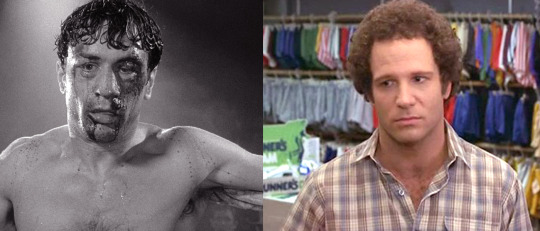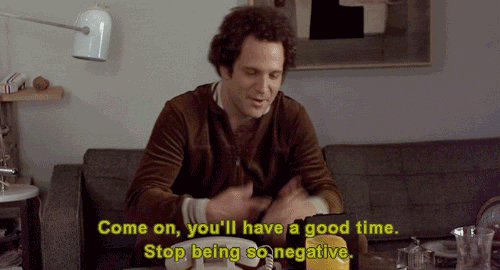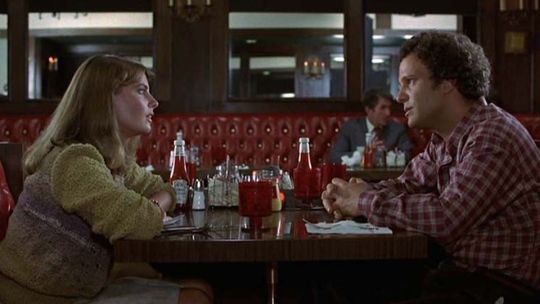The Raging Bull of Albert Brooks Modern Romanceby Scott Tobias
By Yasmina Tawil

Youve heard of a no-win situation, havent you?… Vietnam; this. Albert Brooks, Modern Romance
LaMotta vs. Janiro. There are some ugly fights in Raging Bull, like when Jake LaMotta (Robert De Niro) drops his arms and takes the punishment he thinks he deserves, holding himself upright as his own blood drips from saturated ropes. But not on this night. Jake is the one meting out punishment to Tony Janiro, a young middleweight challenger, and hes doing it almost entirely with blows to the head. His wife Vickie (Cathy Moriarty) had mentioned in passing that Janiro was handsome and Jake, consumed by pathological jealousy, wants to break the kids face for it. When Janiro hits the floor, Jake raises his arms and flashes a malevolent smile in Vickies direction. He aint pretty no more, says a ringside observer.
Then the cycle begins again.
Albert Brooks Modern Romance came out a year after Raging Bull, and at no point does Brooks Robert Cole resort to fisticuffs over Mary Harvard (Kathryn Harrold), his on-again/off-again girlfriend. Raging Bull is a black-and-white period drama and Modern Romance is a contemporary romantic comedy, but the two films play like companion pieces, each a disturbing and unrelenting profile of male jealousy and obsession. Jake exerts power through brute force, every bit the ferocious animal the title implies; Robert resorts to relentless passive-aggression, masking his emotional violence with the assurance that passion dictates his possessiveness. Jake thrashes his opponents in the ring, and turns on his wife, his brother (Joe Pesci), and finally himself. For Robert, the words I love you act like a soft punch that sting in the same way, because they keep him in a relationship that brings joy to neither party, but staves off the possibility that Mary can be with anyone else but him.
For Brooks to smuggle these insights into a comedyand an exceptionally funny one at thatis an achievement that should be respected as much as Martin Scorseses perennial best-of-all-time favorite, but rarely gets the same acknowledgement, if it gets acknowledged at all. (One exception: Stanley Kubrick, who loved Modern Romance so much that he reportedly contacted Brooks out of the blue to ask him how he pulled it off. It sounds absurd until you consider how much Kubricks Eyes Wide Shut taps into the same phenomenon.) Much like Brooks debut feature, Real Life, Modern Romance is a bold act of comic deconstruction, starting with the deliberately blunt title, which isnt about romance any more than the earlier film was about life. Before making movies, Brooks stand-up, short films, and talk-show appearances made delicious sport out of breaking down tired gags, like ventriloquism, celebrity impersonations, and the spit-take. Modern Romance promisesand, in its perverse way, deliversa love story for our time, but it relentlessly exposes the impulses that keep bad relationships going, bonded in perpetual dysfunction.

Brooks wastes no time. In the very first scene, Robert breaks up with Mary, likening their no-win situation to the Vietnam War. Mary rolls her eyes. This has happened before. We dont know how many times theyve broken up and gotten back together before, but Modern Romance opens somewhere in the middle of their relationship, not the beginning of it. And as the film unfolds, we can see plainly why they dont work as a couple. They have nothing in common. She works at a bank and he works as a film editor, and both have trouble even feigning interest in the others job. They fight constantly, which at least leads to great make-up sex. Theres no evidence they even like each other. Robert uses the word love to express a burbling cauldron of ugly emotions; Mary seems so worn down by his relentless entreaties that she keeps coming back.
The relationship would end if not for two related factors: 1. Robert cannot be alone for a second. 2. Robert cannot bear the thought of Mary sleeping with another man. Modern Romance makes hilarious sport of the former in an extended post-break-up where Robert pops two Quaaludes and spends a long night stumbling around his apartment, making phone calls to his assistant editor (Bruno Kirby), arranging a rebound date with a woman he cant even remember (I didnt even think you liked me, she says), and chatting up his pet bird Petey. To continue the Raging Bull analogy, the scene is like the comic equivalent of LaMotta alone in the jail cell, pounding the walls with his fists as if trying to break through the prison of his own conscience. These are metaphorical walls that both men have constructedand in Roberts case, not even a couple of ludes can soften the concrete.





